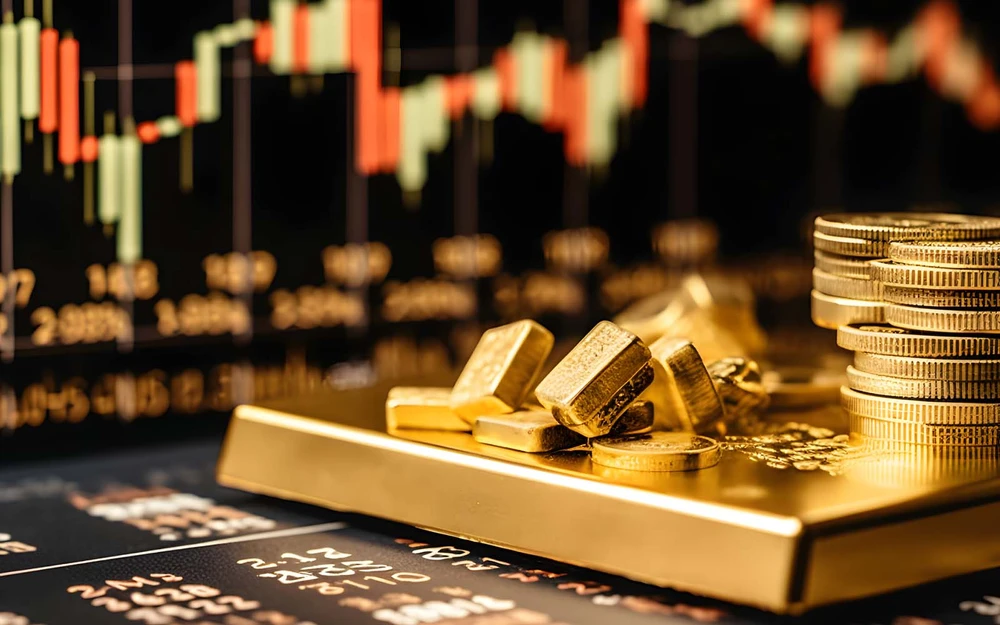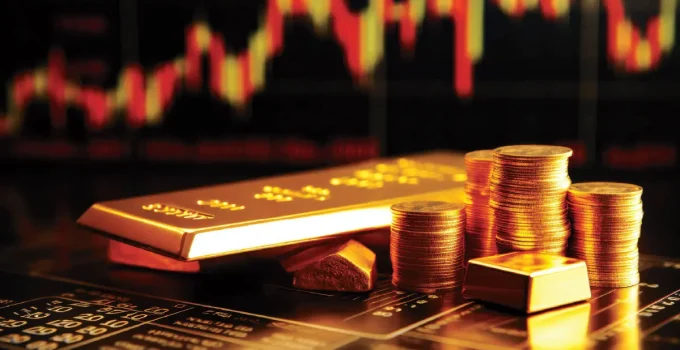In a significant turn of events, the gold price has soared to a record high, leaving both investors and analysts stunned. This sudden surge can be attributed to two major factors: the decisions made by the Federal Reserve (Fed) and the escalating global unrest. As the Fed continues to implement dovish policies, slashing interest rates and injecting money into the economy, investors seek refuge in gold as a safe haven asset.
The uncertainty surrounding the ongoing trade tensions, political instability, and global economic slowdown further exacerbates the demand for gold, pushing its price to unprecedented levels. This article delves into the impact of the Fed’s decisions on the gold market and examines how global unrest is fueling the rise in gold prices. We will also explore the implications for investors and provide insights on how they can navigate this volatile landscape. Get ready to uncover the intricate dynamics behind this gold rush and discover how it may shape the investment landscape moving forward.
Factors influencing the price of gold
The price of gold is not a standalone figure; it is influenced by a myriad of factors, both macroeconomic and geopolitical. As a precious metal, gold has a high intrinsic value and has long been considered a safe haven asset. This means that during times of uncertainty and economic turbulence, investors often flock to gold as a secure place to store their wealth. This increased demand pushes up the price.
However, the price of gold is not solely dictated by demand. Just like any other commodity, its price is also impacted by its supply. Gold mining companies and central banks hold significant sway over the supply of gold in the market. If they decide to release a large amount of gold onto the market, this could potentially dampen the price. Conversely, if they hold back on releasing gold, this could push prices higher.
Moreover, the strength of the US dollar also has a significant impact on gold prices. Since gold is traded globally in US dollars, a strong dollar makes gold more expensive for buyers using other currencies, which can suppress demand and consequently, the price of gold. Conversely, a weaker dollar can make gold cheaper, stimulating demand and driving up the price.

The role of the Federal Reserve in gold price fluctuations
The Federal Reserve, or the Fed, plays a crucial role in the fluctuation of gold prices. The Fed’s monetary policies, including interest rate decisions and quantitative easing measures, have a direct impact on the value of the US dollar and consequently, the price of gold.
When the Fed lowers interest rates, it reduces the opportunity cost of holding gold. Since gold does not pay any interest or dividends, when interest rates are high, investors are more likely to divert their funds into interest-bearing assets such as bonds. However, when interest rates are low, holding gold becomes more attractive. This drives up demand and subsequently, the price.
Furthermore, the Fed’s quantitative easing measures, which involve the buying of government bonds to inject money into the economy, often lead to inflationary pressures. Since gold is often viewed as a hedge against inflation, these measures can also increase the demand for gold and drive up its price.
Impact of global unrest on the gold market
Global unrest, encompassing everything from political instability, trade disputes, to economic slowdowns, can profoundly influence the price of gold. During these times of uncertainty, investors often seek a safe haven to protect their wealth, and gold is one of the most popular choices.
The ongoing trade tensions between major economies such as the US and China have created a sense of uncertainty in the global markets. This uncertainty has increased the appeal of gold as a safe haven asset, leading to a surge in demand and subsequently, an increase in price.
Similarly, political instability, whether it is Brexit in the UK or civil unrest in Hong Kong, can also drive investors towards gold. The economic slowdowns experienced by many countries, exacerbated by the COVID-19 pandemic, have also bolstered the demand for gold as a reliable store of value.
Historical trends in gold prices
Looking at the historical trends in gold prices can provide valuable insights into its future performance. Over the past few decades, gold prices have experienced significant fluctuations, influenced by a combination of factors including inflation, interest rates, geopolitical events, and economic crises.
During the 1980s and 1990s, gold prices were relatively stable, with the price hovering around $300 to $400 per ounce. However, following the financial crisis of 2008, gold prices started to soar, reaching a peak of over $1,900 per ounce in 2011. This surge was driven by the extraordinary monetary easing measures taken by central banks worldwide, which stoked fears of inflation and drove investors towards gold.
After a period of correction and consolidation, gold prices have started to climb again in recent years, driven by escalating trade tensions, low interest rates, and global economic uncertainty. This upward trend culminated in the recent record-breaking price, underlining gold’s enduring appeal as a safe haven asset.
Recent record-breaking gold prices
In a remarkable turn of events, gold prices have recently hit a record high. This surge has been driven by a combination of factors including dovish monetary policies implemented by the Fed, ongoing global trade tensions, political instability, and the global economic slowdown caused by the COVID-19 pandemic.
As central banks across the world cut interest rates and pumped money into the economy to mitigate the economic fallout from the pandemic, investors have flocked to gold as a secure store of value. This has pushed the price of gold to unprecedented levels, surpassing its previous peak in 2011.
It is worth noting that this recent surge in gold prices has not been confined to the US market. Gold prices have also hit record highs in many other currencies, reflecting the global nature of this gold rush.

How investors can take advantage of rising gold prices
With gold prices reaching record highs, many investors may be wondering how they can take advantage of this trend. There are several ways to invest in gold, each with its own set of benefits and risks.
One of the most direct ways to invest in gold is by buying physical gold, such as gold bars or coins. This allows investors to hold a tangible asset that has intrinsic value. However, this method comes with storage and insurance costs, and the need for secure transportation.
Alternatively, investors can buy gold exchange-traded funds (ETFs) or gold mining stocks. Gold ETFs track the price of gold and provide a convenient way to gain exposure to the gold market without the need to deal with physical gold. Gold mining stocks, on the other hand, offer potential for high returns but also carry greater risk due to their sensitivity to gold price fluctuations and operational risks associated with mining.
Risks and challenges of investing in gold
While investing in gold can offer potential rewards, it also comes with risks and challenges. One of the main risks is the volatility of gold prices. Just as gold prices can soar, they can also plummet, which can lead to significant losses for investors.
Another risk is currency risk. Since gold is priced in US dollars, investors using other currencies are exposed to exchange rate fluctuations. If the tvtoto strengthens, gold becomes more expensive for these investors, which can dampen demand and lead to a drop in gold prices.
Furthermore, investing in gold does not provide any income in the form of interest or dividends. This means that gold investors may miss out on potential income from other investments. It’s also worth noting that gold does not have any practical use other than as a store of value, unlike other commodities such as oil or agricultural products.
Gold price predictions and expert opinions
Predicting the future price of gold is no easy task, given the multitude of factors that can influence its price. However, many experts believe that the current conditions that are driving up gold prices are likely to persist for some time.
The ongoing monetary easing measures by central banks, the global economic uncertainty caused by the COVID-19 pandemic, and escalating geopolitical tensions are all contributing to the bullish outlook for gold prices. Some experts even predict that gold prices could surpass $2,000 per ounce in the near future.
However, it’s important to note that these predictions are not set in stone. Any sudden changes in the economic or geopolitical landscape could shift the demand for gold and impact its price. Therefore, investors should always do their own research and take expert opinions with a grain of salt.
What the future holds for gold prices
In conclusion, the future of gold prices remains uncertain. While the current conditions suggest a bullish outlook for gold, unforeseen changes in the economic or geopolitical landscape could alter this trajectory.
What is certain, however, is that gold will continue to play a key role in the global financial system. As a safe haven asset, gold will always be sought after in times of uncertainty and turbulence. Therefore, despite the risks and challenges, investing in gold can provide a valuable hedge against economic instability and preserve wealth in volatile times.
As we navigate this uncertain landscape, it’s crucial for investors to stay informed and make well-informed decisions. The recent gold rush serves as a stark reminder of the intricate interplay between economic policies, global unrest, and the gold market. Understanding these dynamics can help investors navigate the volatile world of gold investing and potentially reap the rewards.
Also read: The Magic Reborn: How ‘Willy Wonka & the Chocolate Factory’ Captivates Hearts in 2024




